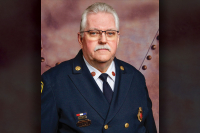More on the saga of Kephart’s arrival at Hazel Creek
 To the Editor:
To the Editor:
Readers may well be approaching exhaustion with this ongoing exchange regarding circumstances surrounding Horace Kephart’s arrival at Hazel Creek, but since his death the Kephart saga has been misrepresented to a degree rivaling the pervasive stereotyping and inaccuracies found in Our Southern Highlanders (OSH). We feel it important to delineate some factual verities.
George Ellison observes in his Aug. 27 article, “Digging Deeper into the Kephart-Calhoun Relationship,” that “By 1904, Granville was married to Lillie Hall.” Multiple public records, such as the 1900 census, indicate that the Calhouns married in the mid-1890s. That does not make Ellison’s statement false; in fact, he carefully worded it to be true. So where does the 1904 date come from? Obviously, that is the date Kephart arrived on the scene. Strangely, particularly given his emphasis on the Kephart-Calhoun relationship in this publication, he does not mention Calhoun at all in his Introduction to Smoky Mountain Magic even though he goes into considerable detail on Kephart’s arrival at and subsequent stay in the Hazel Creek area. This is a significant omission.
We previously presented primary source data, in the form of independent weather records from four regional weather stations, which completely refute the proposition that cited “diary index” entries reflect the period of travel between Dicks Creek and Medlin. The data were archived and are made available by the N.C. Climate Office. Ellison attempts to discount this by noting that Kephart mentioned a barefoot boy in snow in OSH. That OSH reference apparently refers to the passage which reads:
“In winter, one sometimes may see adults and children going barefoot in snow that is ankle deep. It used to be customary in our settlement to do the morning chores barefooted in the snow.”
Related Items
Relying on OSH, which is littered with inaccurate information for any “proof” is questionable, and there is no indication whatsoever that this “barefooted in the snow” episode is connected with Kephart’s arrival at Hazel Creek. You don’t have snow-laden ground when temperatures are consistently well above freezing and there is no precipitation.
Both the marriage date and the barefoot in snow examples indicate a disturbing, Kephart-centric frame of reference. From a historical perspective, that is as troubling as the attempt to write a new version of the story based on a paucity of facts.
Even those purported “facts” must be questioned. In his Aug. 27 article, Ellison states that in addition to relying on the demonstrably flawed diary index, he places “considerable reliance on Kephart’s Photo Album, which they (Casadas) don’t mention.” Well, neither had Ellison previously mentioned his reliance upon the album. It hardly seems reasonable to expect us to respond to something which hadn’t been cited.
But now that it has, we will.
On the WCU website page: www.wcu.edu/library/digitalcollections/kephart/photoalbum/About.htm
the following is noted: “During his lifetime, Horace Kephart made changes to his photograph album. Similar to his research journals, the album evolved with his interests and experiences. Many captions have been erased and rewritten. This may reflect a reorganization of photographs or updated phrases to describe them.”
The WCU webpage goes on to note:
“Matching this index to the first pages of the album shows a purposeful selection of subjects in support of a planned book.” (our emphasis)
Not only have captions been erased and rewritten – clearly many were written years after the photo was taken. Those are not the only changes made to the photograph album. On page 44 of the album www.wcu.edu/-library/digitalcollections/kephart/photoalbum/pg44_45.htm), an individual has apparently clipped out of a pair of photographs. Is this compatible with the behavior of an “inveterate library cataloger,” as Ellison refers to Kephart?
There is even inconsistency between the modified photograph album and OSH. Ellison alludes to the caption under a missing photograph where Kephart stated he “lived here alone, Nov. 2, 1904, to Jan. 1906.” But in the first edition of OSH, a copy of the photograph labeled “The Cabin in Winter” on the WCU website includes a caption where Kephart states “the author lived alone for three years.” Three years is 240 percent of 15 months by our counting, but it is entirely consistent with the distortion and exaggeration found throughout the pages of OSH.
Ellison also attempts to cite inconsistencies from the Michael Frome and Carson Brewer accounts of their interviews with Calhoun Yes, there are minor variations in their words — exactly the sort one would expect from separate retellings. Yet both agree on fundamental elements:
• Both have Kephart arriving in a degraded state of health.
• Both have the mode of transportation by mule, not horse
• Both have him being given strawberry wine to drink.
• Both have him being given a second glass of wine.
• Both have Kephart’s eyes brightening.
• Both have him subsequently drinking a bit of milk.
• Both relate the time that Kephart was cared for in weeks (three according to Frome, several according to Brewer).
Ellison and Ken Wise, whom Ellison cites in his Sept. 10 article, have both inferred the Frome and Brewer accounts to claim that Kephart actually stayed in the Calhoun home for three (or several) weeks. Yet neither author specifically states that to be the case. Both clearly indicate that there was a period of nursing back to health, but that is not the same as saying he spent all that time at the Calhoun home. Seymour Calhoun, the oldest child of Granville and Lillie Calhoun, and who would’ve been seven years old at the time, recalled in a 1974 interview that Kephart:
“... used to come down to the post office there, the post office was in a little store we had there at the house and after he got till, I mean he got, you know, till he could walk and come from his cabin down to the store ….”
The clear implication is that there was a period where Kephart was simply unable to navigate the relatively short, moderate grade trip between the cabin and the store alone. The combination of evidence strongly suggests that Calhoun brought Kephart to Sugar Fork, helped him settle into his “Back of Beyond,” and then tended to him until he was somewhat able to make do on his own.
This entire episode brings to mind an observation by Waynesville Judge Felix Alley in Random Thoughts and Musings of a Mountaineer. Alley knew Kephart by virtue of many stays at the Cooper House during court proceedings in Bryson City. He stated he loved Kephart as a friend, but went on to say that both Kephart and Margaret Morley of Boston (author of The Carolina Mountains) “like all other writers about our people, write to be interesting and not to tell the truth; their primary object, with respect to what they say about our mountaineers being, to write books that would sell in the North.”
The invention of a new timeline contradicts a story consistently told by Calhoun as recorded by two professional journalists and buttressed by independent facts. Ellison relies on a demonstrably flawed “diary index” and a caption beneath a missing photo from a heavily modified photograph album which conflicts with the length of time cited by Kephart in OSH. He completely ignores or dismisses conflicting primary sources, exactly the approach Alley bemoaned three-quarters of a century ago. It might “sell in the North.” We’re not buying.
Don Casada, Bryson City
Jim Casada, Rock Hill









